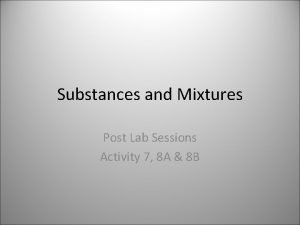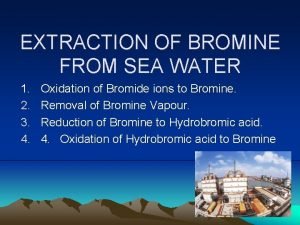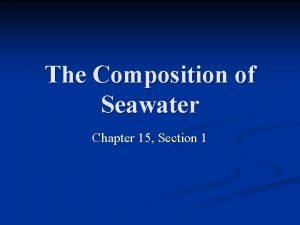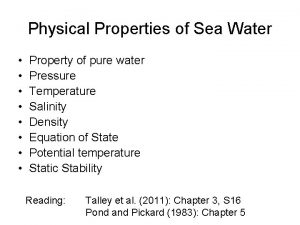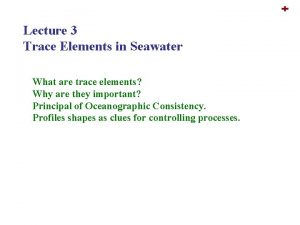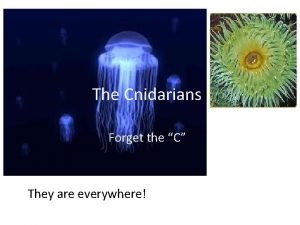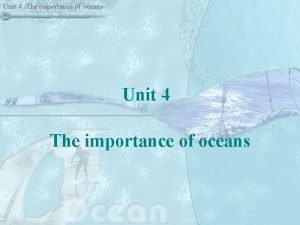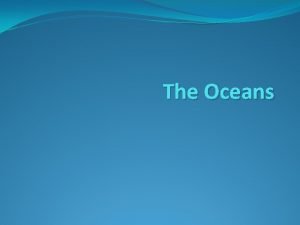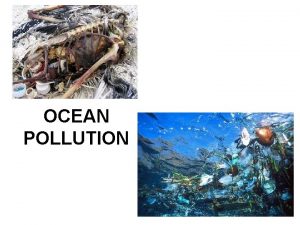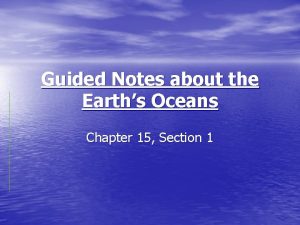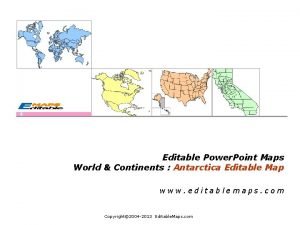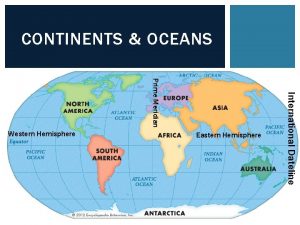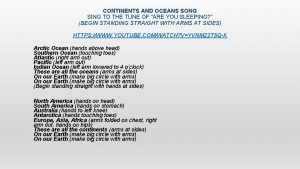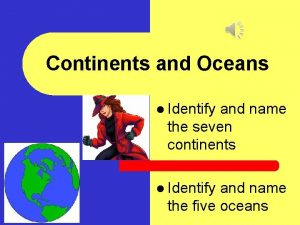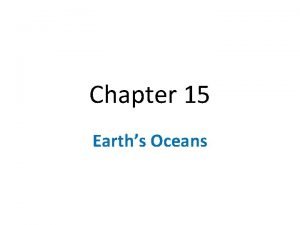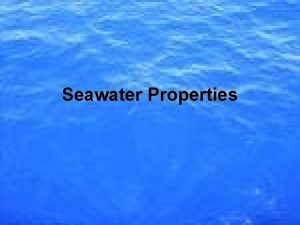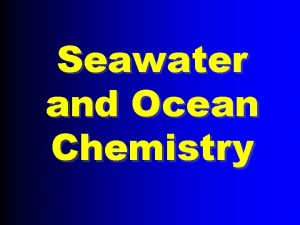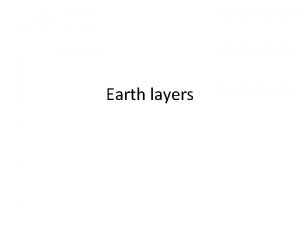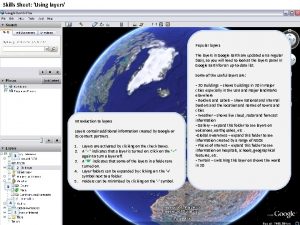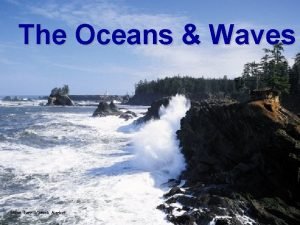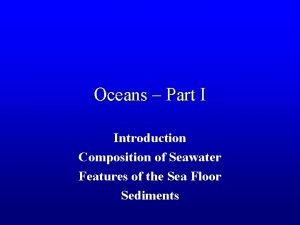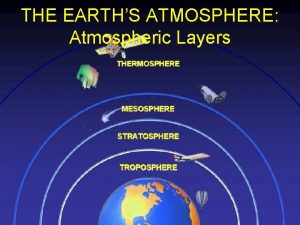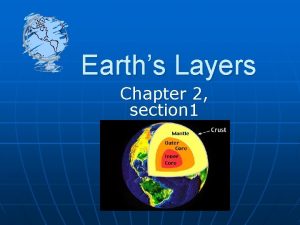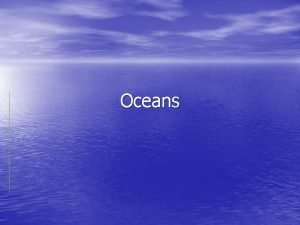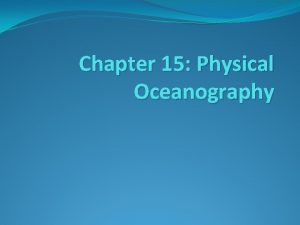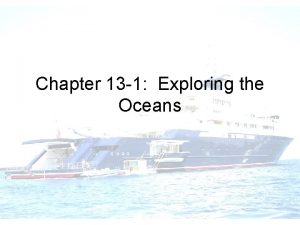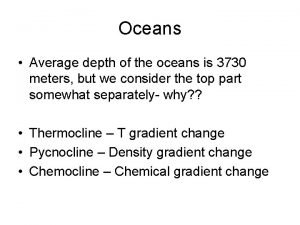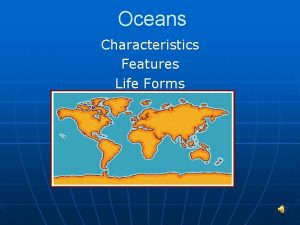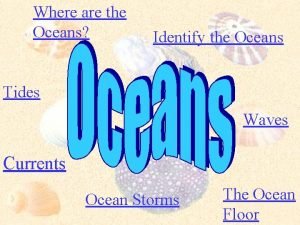Section 2 Seawater Oceans have distinct layers of



























- Slides: 27

Section 2: Seawater Oceans have distinct layers of water masses that are characterized by temperature and salinity. K What I Know W What I Want to Find Out L What I Learned

Essential Questions • What is the composition of seawater? • What are the physical properties of seawater? • How is ocean layering illustrated? • How do deepwater masses form? Copyright © Mc. Graw-Hill Education Seawater

Vocabulary Review New • • • feldspar Copyright © Mc. Graw-Hill Education salinity estuary temperature profile thermocline Seawater

Chemical Properties of Seawater • Ocean water contains dissolved gases, including oxygen and carbon dioxide, and dissolved nutrients such as nitrates and phosphates. Copyright © Mc. Graw-Hill Education Seawater

Chemical Properties of Seawater • Levels of dissolved gases and nutrients in seawater vary by location and depth. Copyright © Mc. Graw-Hill Education Seawater

Chemical Properties of Seawater Salinity • • The measure of the amount of dissolved salts in seawater is salinity. Oceanographers express salinity as grams of salt per kilogram of water, or parts per thousand (ppt). Copyright © Mc. Graw-Hill Education Seawater

Chemical Properties of Seawater Variations in salinity • Although the average salinity of the oceans is 35 ppt, actual salinity varies from place to place. Copyright © Mc. Graw-Hill Education Seawater

Chemical Properties of Seawater Variations in salinity • The lowest salinity often occurs where large rivers empty into the oceans, creating areas of water called estuaries. • Even though salinity varies, the relative proportion of major types of sea salts is constant because all ocean water continually intermingles throughout Earth’s oceans. Copyright © Mc. Graw-Hill Education Seawater

Chemical Properties of Seawater Sources of sea salt • Geologic evidence indicates that the salinity of ancient seas was not much different from that of today’s oceans. • Sources of sea salts have also stayed the same over time. Copyright © Mc. Graw-Hill Education Seawater

Chemical Properties of Seawater Sources of sea salt • Sulfur dioxide and chlorine, gases released by volcanoes, dissolve in water, forming sulfate and chlorine ions. • Most of the other ions in seawater, including sodium and calcium, come from the weathering of crustal rocks, such as feldspars. • Iron and magnesium come from the weathering of rocks rich in these elements. These ions enter rivers and are transported to oceans. Copyright © Mc. Graw-Hill Education Seawater

Visualizing the Salt Cycle • Salts are added to seawater by volcanic eruptions and by the weathering and erosion of rocks. Salts are removed from seawater by biological processes and the formation of evaporites. Also, wind carries salty droplets inland. Copyright © Mc. Graw-Hill Education Seawater

Visualizing the Salt Cycle Concepts In Motion FPO Add link to Animation from p. 415 here. Copyright © Mc. Graw-Hill Education Seawater

Chemical Properties of Seawater Removal of sea salt • In arid coastal regions, water evaporates from seawater and leaves solid salt behind. • Marine organisms remove ions from seawater to build shells, bones, and teeth. Copyright © Mc. Graw-Hill Education Seawater

Chemical Properties of Seawater Removal of sea salt • Winds can pick up salty droplets from breaking waves and deposit the salt further inland. • The existing salinity of seawater represents a balance between the processes that remove salts and those that add them. Copyright © Mc. Graw-Hill Education Seawater

Removal of Sea Salts Concepts In Motion FPO Add link to Interactive Table from p. 416 here. Copyright © Mc. Graw-Hill Education Seawater

Physical Properties of Seawater Density • Because salt ions add to the overall mass of the water in which they are dissolved, they increase the density of water. Seawater is therefore more dense than freshwater, and its density increases with salinity. Copyright © Mc. Graw-Hill Education Seawater

Physical Properties of Seawater Density • Temperature also affects density—cold water is more dense than warm water. • Because of salinity and temperature variations, the density of seawater ranges from about 1. 02 g/cm 3 to 1. 03 g/cm 3. Copyright © Mc. Graw-Hill Education Seawater

Physical Properties of Seawater Freezing point • Variations in salinity also cause the freezing point of seawater (– 2°C) to be somewhat lower than that of freshwater (0°C). Copyright © Mc. Graw-Hill Education Seawater

Physical Properties of Seawater Absorption of light • Water absorbs light, which gives rise to another physical property of oceans—darkness. • In general, light penetrates only the upper 100 m of seawater. Copyright © Mc. Graw-Hill Education Seawater

Ocean Layering Temperature profiles • This figure shows typical ocean temperature profiles, which plot changing water temperatures against depth. Such profiles vary, depending on location and season. Copyright © Mc. Graw-Hill Education Seawater

Ocean Layering Temperature profiles • In general, ocean layering is caused by density differences. Because cold water is more dense than warm water, cold water sinks to the bottom, while less-dense, warm water is found near the ocean’s surface. Copyright © Mc. Graw-Hill Education Seawater

Ocean Layering Temperature profiles • The thermocline is the transitional ocean layer that lies between the relatively warm, sunlit surface layer and the colder, dark, dense bottom layer. It is characterized by temperatures that decrease rapidly with depth. Copyright © Mc. Graw-Hill Education Seawater

Water Masses Deepwater masses • Dense polar water sinks, producing a deepwater mass. Copyright © Mc. Graw-Hill Education Seawater

Water Masses Deepwater masses • Three water masses account for most of the deepwater masses in the oceans—Antarctic Bottom Water, North Atlantic Deep Water, and Antarctic Intermediate Water. Copyright © Mc. Graw-Hill Education Seawater

Water Masses Deepwater masses • Antarctic Bottom Water is the densest and coldest deepwater mass. It is overridden by the slightly warmer and less dense North Atlantic Deep Water. Copyright © Mc. Graw-Hill Education Seawater

Water Masses Intermediate water masses • Antarctic Intermediate Water is warmer and less dense, and thus it overrides the other two deepwater masses. Copyright © Mc. Graw-Hill Education Seawater

Review Essential Questions • What is the composition of seawater? • What are the physical properties of seawater? • How is ocean layering illustrated? • How do deepwater masses form? Vocabulary • salinity • estuary Copyright © Mc. Graw-Hill Education • temperature profile • thermocline Seawater
 What makes up each of jupiter's three distinct layers
What makes up each of jupiter's three distinct layers Israeli singers have a distinct vocal style in singing
Israeli singers have a distinct vocal style in singing Boiling point of seawater
Boiling point of seawater Chemical properties of seawater
Chemical properties of seawater Bromine in seawater
Bromine in seawater Composition seawater
Composition seawater Characteristics of pure water
Characteristics of pure water Trace elements in seawater
Trace elements in seawater 8 vertices 12 edges 6 rectangular faces
8 vertices 12 edges 6 rectangular faces Emmoilent
Emmoilent Cnidaria tissue layers
Cnidaria tissue layers Csection layers
Csection layers Csection layers
Csection layers Importance of marine life
Importance of marine life Importance of oceans
Importance of oceans Earth covered in water
Earth covered in water Are all the oceans connected
Are all the oceans connected Ocean the part day after day
Ocean the part day after day Size of great pacific garbage patch
Size of great pacific garbage patch Oceans 7/11
Oceans 7/11 Chapter 15 earth's oceans study guide answer key
Chapter 15 earth's oceans study guide answer key Outline map of continents and oceans
Outline map of continents and oceans Eastern hemisphere oceans
Eastern hemisphere oceans Continents and oceans for kids
Continents and oceans for kids Five oceans song
Five oceans song 7 continents 5 oceans map
7 continents 5 oceans map Hemispheres continents and oceans
Hemispheres continents and oceans Chapter 15 earth's oceans
Chapter 15 earth's oceans


